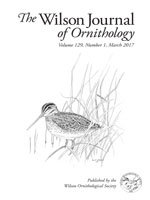Between 2013–2015, we conducted a study on the breeding biology of the Wren-like Rushbird (Phleocryptes melanops) in wetlands of the Pampas region, Argentina. The search for rushbird nests was conducted by several researchers walking into the wetlands, in three ways: by observing adults carrying material, through singing adults next to the nest or from the active search for nests in the vegetation. Nests were visited at intervals of 3–5 days. Of the 245 nests that we encountered (153 nests in 2013–2014 and 92 nests in 2014–2015), we found eggs in 97. The egg-laying period lasted almost 3 months (late Sept–late Dec). The mean clutch size was 2.7 ± 0.5 eggs (mean ± SD) (range = 1–3; n = 63), and the total nesting period was 34 ± 2.5 days (mean ± SD), with incubation and chick-rearing periods of 18 ± 1.63 days and 16 ± 0.50 days, respectively. From the total number of nests found, 43% of them were abandoned during building, 38% of nests were depredated, 14% of nests (n = 33) were successful, while 5% of nests were destroyed. Nest predation was higher during the incubation (80%) than during chick-rearing period (20%). The nesting success was on average of 23% (25% for the 2013–14 and 21% for the 2014–2015) for the entire nesting period. We also observed relatively higher plasticity than previously reported in relationship to vegetation used to fix nests (80% rushes, 20% other plants). Finally, we observed an abrupt termination of the reproductive period after desiccation of the wetlands; 90% of active nests failed (75% depredated and 25% abandoned) when the wetland was dried.
How to translate text using browser tools
1 March 2017
Breeding biology of the Wren-like Rushbird (Phleocryptes melanops) in the southeast Pampas of Argentina
Nicolás M. Chiaradia,
D. Augusto Cardoni,
Matías G. Pretelli,
Juan P. Isacch
ACCESS THE FULL ARTICLE
breeding success
furnariid
nest structure
reproductive phenology
rushes
Wetlands





